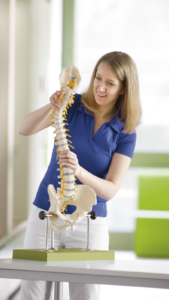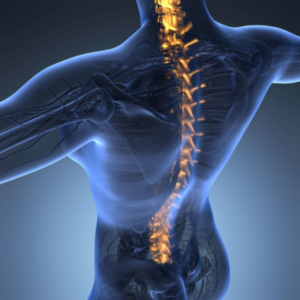The Spinal Series that we just completed was intended to provide you with general information on the most common spinal issues. In order to have complete knowledge of the subject, it’s important to also have a basic understanding of the human spine!
Human Spine: The Vertebral Column 
The human spine or vertebral column is composed of individual vertebrae, sections of bone that house the spinal cord, separated by soft jelly discs. There are five sections in the vertebral column – cervical, thoracic, lumbar, sacrum, and coccyx (or tailbone). All humans are born with 33 vertebrae, 24 that comprise the main sections (cervical, thoracic, and lumbar), 5 which fuse during development to form the sacrum, and 3-5 which fuse together to form the coccyx. The cervical spine is located in your neck and has 7 vertebrae, the thoracic spine has 12, and the lumbar or lower back has 5.
When there is a spinal injury, it usually occurs in the cervical or lumbar regions. This is can be due to the fact that in many, the thoracic spine does not have proper mobility which can place more stress on the upper and lower portions of the human spine. The cervical and lumbar regions are meant for stability and the stress can cause injury.
Do You Have a Spinal Condition? Schedule an Appointment Today!
If you have any questions, or want a consultation with a professional, feel free to call, or schedule an appointment online at any of our Bergen County or Passaic County offices in New Jersey. Choose from Glen Rock, Franklin Lakes, Fair Lawn, Ho-ho-kus/Ridgewood, and/or Clifton – we make it possible for you to visit any of our offices at your convenience.
Intervertebral Discs
In between each vertebra is a disc that has a harder fibrous outside and a softer jelly like inside. The discs absorb shock, allow movement, and act as a ligament that connects the upper and lower vertebra. Discs can rupture due to trauma or age and bulge or herniate. The jelly on the inside can spill out which may put pressure on the spinal cord or nerves coming out and cause pain.
Spinal Cord 
Housed in the vertebral column is the spinal cord. With the brain the spinal cord forms the central nervous system(CNS). The spinal cord connects the brain to the complex system of nerves that run throughout the body, which together form the peripheral nervous system(PNS). The PNS and CNS together form our body’s nervous system. The ways in which the two interact can get complicated but just know that information is constantly sent from the brain, to the spinal cord, to the nerves of the peripheral nervous system and back throughout the day. Together these systems cause many involuntary contractions, hormone production, and other important processes that are vital for survive. The peripheral nervous system provides feedback from the environment that is sent up to the brain for interpretation. This process happens instantly, and we are rarely aware of it. This is what makes the spinal cord crucial, it is the only way for information to reach the brain. Sections of the spinal cord can be damaged and we can function but systems of the body can be shut down.
The areas affected depend on where the trauma occurred and the severity of it. For example, if something happens in your cervical spine, you can lose function of your entire body (quadriplegia) or just sections if it occurs in your thoracic or lumbar areas (paraplegia).
Trauma can also happen to the vertebral column and again, the result will depend on severity and location.
Common spinal conditions that we’ve covered in The Spinal Series include:
Do you suffer from a spinal condition? Contact Us To Schedule An Appointment Today.





